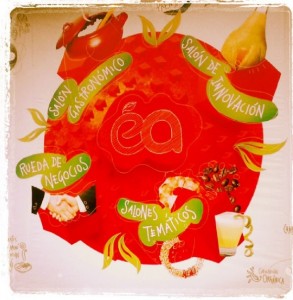It is not often that I get a chance during a business trip to step out of the routine for a few hours and enjoy something different. But when I knew that ExpoAlimentaria was on in Lima when I last visited, I just couldn’t miss the chance to visit one of the largest and most professional food and drink shows in Latin America. 
And I was impressed. The organisation of the event was of international quality, nothing to envy shows in Brazil, Germany or the UK. The quality of the stands was excellent: Peru is clearly making the most of its recent credentials as the culinary capital of Latin America. Food producers ranged from those with traditional Peruvian delicacies such as pisco, to those betting for the steep growth in organic produce in Latin America (chocolate, quinoa and chia stood out for me) to those more focused on exports of some amazing fresh produce (fish, fruit, vegetables, grains and more). But that wasn’t it. There was also a large area dedicated to services and to technology, machinery and equipment. And then there were the international pavilions or international stands, from Malaysia to Mexico, from Holland to Argentina.
No, I didn’t spot any Union Jacks, which is a real shame given the size and growth of the Peruvian market, and the importance of this show at a regional level. We’ve already covered that in another blog post. But German, Spanish, Italian and Dutch companies did seem to be grasping the opportunities.
I made some good contacts for clients in food processing and food service. I also got some really useful information (from directories to business cards) for future projects and for contacts here in Uruguay, who are looking up to Peru to do business. And rightly so. Here are some recent statistics on the Peruvian food and drink sector:
– EU statistics show that:
- In 2012 the EU was Peru’s 3rd main trading partner after China and the US
- EU imports of “food and live animals” from Peru in 2012 totalled 1890 million Euro, 30% of imports from that country
- The main export of the EU to Peru is machinery and transport equipment
– With respect to the UK in particular, “British exports to Peru increased by 28% in 2011 and by the end of 2014. We hope to see exports double from US$120 million in 2010 to US$240 million by 2014” (UKTI, 2012)
– With a 6.1% growth forecast by the IMF for this year, Peru’s demand for food and drink is increasing, not only by households (with clear shifting patters due to a growing middle class and a decline in poverty) but also by restaurants and hotels.
– Peru is also one of South America’s largest food exporters. Some of its main produce available in the UK includes asparagus and organic coffee.
Want to know more about food and drink in Peru? This BBC article from 2009 gives you an idea of what is going on in this country, and moving forward to 2013, check out this Conde Nast Traveller article on Peru as the culinary capital of Latin America.
Inspired? We have been to Lima three times this year and have worked for many clients on market research and distributor recruitment projects involving Peru. We’d love to hear from you.
